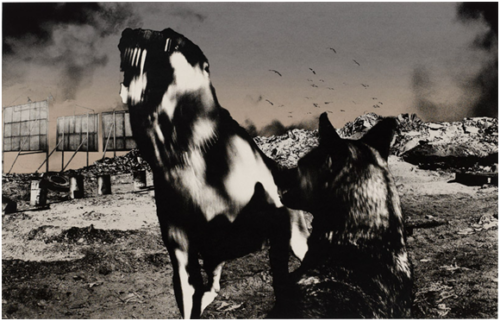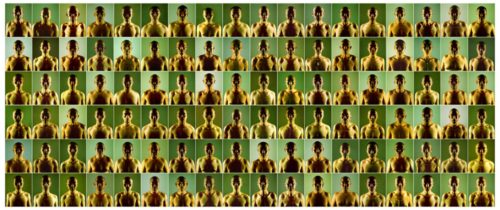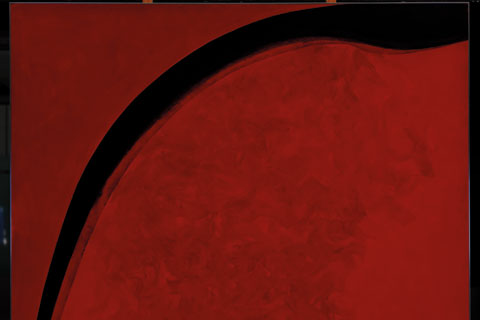
Gunnel Wåhlstrand
“You neglect and belittle the desert.
The desert is not remote in southern tropics
The desert is not only around the corner,
The desert is squeezed in the tube-train next to you,
The desert is in the heart of your brother.”
T. S Eliot (Choruses from The Rock)
“This Skin Ego is a colander: thoughts and memories are only with difficulty retained; they leak away.”
Didier Anzieu
“War is to man what maternity is to the woman. I do not believe in perpetual peace; not only do I not believe in it but I find it depressing and a negation of all the fundamental virtues of man.”
Benito Mussollini
There is something in contemporary life, in the West, and primarily I am thinking of the United States, that suggests an inability to abstract absence from the image or reality before us. And I think this is related to a deep privation in social relations. I do not know any other way to explain the collective pathology of so many people in the U.S. today. I am aware that there are many out there who are as disturbed as I am by the state of society. I am aware that the system of image reproduction and circulation works overtime to erase these people, and it is perhaps important in a sense to remember this erasure. For this manipulation of opinion, this apparatus of propaganda, is always acting to protect the value and property of the ruling class. And so this erasing process never stops. But, having said that (and I will return to this) there remains a significant number of people who simply do not see what is in front of them.

Guo Haiqiang
It is more than that, though. And this *more* is best examined, or lets say is best examined because best expressed in terms of aesthetics. I always return to aesthetics, but that is me and this what concerns and compels me. The entertainment industry has to be discussed (and I will) but there are qualities of social life today that are, I believe, unique in human history.
“Lacan explicitly endorses Levi-Strauss’s conception of the transcendental law at the origin of human sociality as the incest taboo; he writes that “the fundamental or primary law, the one where culture begins in opposition to nature, is the law of the prohibition of incest” (Lacan 1992 [1986], 66–7). The intrusion of language and law institutes a break with nature, one that transfigures the world by imbuing it with meaning. Following the logic of Totem and Taboo, social identities are constituted on the basis of exclusions that establish kinship networks. These social bonds are maintained through mandates and prohibitions (what is required and what is forbidden), and in particular through the mandate of exogamy (with its structures of exchange) which determines that “the Oedipus complex is both universal and contingent”… paternal prohibition provides the conditions for human sociality without the prohibition itself being innate.”
Emily Zakin

Jo Ratcliffe, photography.
This idea of exclusion forming the etiological framework for society feels correct to me. And in a way this is the framework for aesthetics, too. And one sees this in the cultures of antiquity. Prohibitions are linked, often directly, with regulation of image and word. But the overriding sense one has, or that *I* have at least, is that the generalized autism that Debord mentioned, somewhat metaphorically, fifty years ago, has become more acute. If one looks at the work of psychoanalysts like Judith Mitraini and Joyce Mcdougall, or Francis Tustin, they posit a kind of premature and catastrophic rupture in the infants relationship with the mother. Melanie Klein saw the Death Instinct at work in this inability to unify into an emotionally stable adult. And Tustin in particular, who has theorized extensively about the origins of autism, sees this rupture from the mother partly the result, if not usually the result, of a deficient mother. If the mother herself, the caregiver, is fragmentary or emotionally compromised somehow, then the infant and child will suffer a crippling terror that looms as a black hole from which they must protect themselves. And this paradoxical relationship to prohibition cuts across all of this.
“A theme that also runs through all these clinicians’ work is that what was missing here was a safe haven in the form of the arms of a tender but firm mother. Neither a harsh mother nor a marshmallow mother (as Frances Tustin termed it) could provide the atmosphere that the baby needs to be able to develop a healthy centre, a wholesome ego, capable of bringing all parts together. There is then the sense that what we are witnessing in such a patient is the casualty of a primordial disaster – an elemental failure that has left him victim to inner and outer forces over which he has no government. It is particularly difficult to see these disasters when what has constituted them has been an absence or a failure.”
Neville Symington

Jonathan Owen
That is the key, then; the absence of something. Something that innately is expected or anticipated? It is my suspicion that this difficulty in reading the absent is expressed artistically, too, by the manufacturing of banality. The mass culture of banality has very literal economic and class causes, of course, but it is also, in its popularity, suggestive of a wide audience that welcomes these cosmetic bridges to an artificial wholeness. It is innate, I think, to expect protection.
Tustin has written of the autistic clinging to hard surfaces, or shiny objects. An adhesive quality that reflects emotional instability and vertigo. Not to be too parochial but mass entertainments today (and perhaps all electronic media) are the virtual surfaces that are adhered to, and attached to.
“The need for a containing object would seem in the infantile unintegrated state to produce a frantic search for an object- a light, a voice, a smell, or other sensual object-which can hold the attention and thereby be experienced, momentarily at least… as holding the parts of the personality together.”
Esther Bick

Wang Jinsong
The distracted mother, the distracted nipple in a sense, is a dead nipple — and there is the creation of what Bick called a second skin. Or second skin formation. But then Bick concluded with a very cogent two sentences meant to describe what the infant needed protection from…
“…the catastrophic anxiety of falling-into-space, and the dead-end [which] haunts every demand for change and which engenders a deep conservatism and a demand for sameness, stability and support from the outside world.”
Falling into space. The terrors of absence, of an unrecognized absence. An absence one can only point toward, not really identify. And out of which the children of the distracted epoch are the second or third generation of closeted fascists, of inflexible obsessively oriented toward punishment. The deep conservatism described above is that which has adhered to the shiny surfaces of virtual banality. This is also linked to Freud’s definitions of the anal sadistic character. Karl Abraham saw the anal sadistic in two stages; in the first stage anal sadism is tied to evacuation. And the destruction of the object. In the second stage it is about retention. And retention is an aspect of control, of controlling the object. More on this later.

Robert Zhao Renhui, photography.
Kelly Oliver, writing on Julia Kristeva, who is describing the tortures at Abu Ghraib…
“This “exploded rush toward disinhibitied satisfaction” operates as the counterpoint to the Puritan code, that she identifies with a “ferocious repression,” which robotizes the functions of the new world order. This ferocious re- pression is manifest in policing technologies and professional hyperproductivity, both of which emphasize efficiency in an economy of calculable risks and profits over meaning. On the other side of law become the science of management are ever more violent forms of entertainment: spectacles, scandals, and sexcapades. It is the cleavage between law and desire, between word and affect, between the symbolic and the body, that according to Kristeva can produce teenage torturers who abuse prisoners seemingly in all innocence—as they claim at their trials—“just for fun.””
Kristeva has said before that there is a split between word and affect. Between being and meaning, and that this disconnect is plastered over with a saturation of image. But which results in those images and perhaps any images, reflecting or expressing anything of one’s emotional life. The electronic mass culture now operates in several registers, some in contradiction with each other, but which in all cases (per Kristeva) suspend meaning. Our emotional lives are second skins then, surfaces of inanimate coldness, but also of shine. The phantasmagoric that is enclosed, cryptically, in the technologies of surveillance and punishment.

Dorota Jurczak
“For within the economy of exchange, substitution can never move beyond fetishism; there the dynamic and poetic operations of metaphorical substitution are reduced to products or things. Consumer culture proliferates the empty desire for products that create their own needs and only ever lead to partial, incomplete, and therefore short-lived satisfactions. The rich are idolized for their wealth and property, individuals with things. Individuals themselves become fungible. And monetary value stands in for ethical value.”
Kelly Oliver
Kristeva sees the loss of prohibition as the engine of psychic vertigo; and this would make sense in light of this inability to recognize absence. The premature rupture of the infant from the Mother, or caregiver. Or the coerced rupture of the infant and the dead nipple mother. The distracted parent couple, whose own second skin is subbing for real presence, are then creating children who must increasingly navigate the acute terror that comes from not being able to define borders — boundaries, and whose adhering is not with cold hard surfaces but with the images of cold hard surfaces. And the cold hard surface has incrementally migrated into the aesthetics of a new fascist style.

Cake handed out on Hitlers Birthday. April-20, 1934. Berlin.
I think Kristeva is wrong however when she writes that the soldiers at Abu Ghraib were *innocents* in a sense, just having *fun* (she doesn’t exactly say that, but…). It is rather that innocence is no longer meaningful as an idea. And that fun has always been linked closely with sado/masochistic urges. Fun is what the Puritan desires. Still, the germane issue here, I think, revolves around this quality of psychic privation in the infant. The adult who has adhered to the virtual objects of mass culture is one who remains immune to prohibition. And here it seems important to remember the policing technologies of surveillance, and the illusions of perfection implied. That these technologies don’t work, often, is now beside the point. Surveillance and the images from CCTV and reality TV all suggest an order that mediates repression somehow.
“In his theory of mental development, Winnicott proposed that in the event of a deficiency in mothering, the infant is likely to be subjected to sudden and/or chronic awareness of disconnection, leading to “unthinkable anxieties” associated with the felt state of “unintegration.”
Judith Mitrani

Chuck Webster
The impossibility of recognizing the absent, for the infant, translates at an adult level (and of course this is not exact at all) into the erasing of erasure. The removal of absence as a category. Surveillance does something like this, too. The desire to believe in the technologies of militarism and policing in this second or third generation of the children of distracted parenting results in a worship, or a kind of new theology of control. The seeming indifference to nuclear conflagration in so much of the public, and in almost all of the ruling class, is an expression of a world view in which destruction (and the human suffering that comes of it) is eroticized. But it is a very truncated eros. And I am thinking of MSNBC news anchor Brian Williams…
“We see these beautiful pictures at night from the decks of these two U.S. Navy vessels in the eastern Mediterranean. I am tempted to quote the great Leonard Cohen,” he said. “I’m guided by the beauty of our weapons.”
Trump talks of bombing Syria while also discussing the *beautiful* chocolate cake he was eating. Trump is, of course, a very shiny object, a shiny surface without depth. Obama was, too, of course, only he feigned depth as style component.
“Photography shows us a prior reality, and even if it does give us an impres- sion of ideality, it is never experienced as purely illusory: it is a document of a “reality from which we are sheltered.”
Julia Kristeva

Mussolini
The sense of mass culture as shelter is, I think, correct. Only the shelter is ineffective. It must be constantly in a process of renovation. But here I want to touch again on the writings of Francis Tustin, who was an early and hugely influential writer on autism. Writing here on religious fanatics and zealots:
“…they are mainly concerned with outside surfaces. Superficial characteristics like the colour of a person’s skin, his political colouring, details of his theoretical terminology, or religious f o r n ~ sand ceremonies are seen as being deeply significant.They bludgeon their way through life with global systems which aim to complete the circle, instead of using its incompleteness as a stimulus to creative endeavour. They seek to clamp their unnaturally complete global systems on to themselves and others. …People who are different from them are wicked, corrupt or abysmally wrong. The arch manipulators who Polonius-like hide behind the arras of their false pretensions are keeping at bay the same terrors. All these ‘normal’ types of people are manipulating the outside world to use it as a cloak for their damaged vulnerability. At root, there is such a terror of worse than death that the whole of their functioning is based on a desperate attempt to save their own skin at whatever the cost to other people.”
My sense has always been that those aspects of mass culture and entertainment that are most disturbing are those which market themselves as uplifting and positive. There is nothing quite so terrifying as a *smily face*. This new erased eraser, the children of distraction, and of premature rupture, are very closely aligned in aetiology with the fascist.

Lita Albuquerque
“It is at this point that the process of annihilation is idealized in order to supply the Fascist mind with the qualities essential to delusional narcissism. Mental contents are now regarded as contaminates, and the Fascist mind idealizes the process of purging itself of what it has contained. The cleansing of the self suggests the possible birth of a new, forever empty self to be born with no contact with others, with no past (which is severed), and with a future entirely of its own creation.”
Christopher Bollas
Earlier Bollas writes…“the Fascist mind transforms a human other into a disposable nonentity, a bizarre mirror transference of what has already occurred in the Fascist’s self experience.” That sickness unto death of Kierkegaard, a writer Tustin was very fond of, is a spectre that is rehaunting the Western psyche. Rather, it is unexperienced, it is erased. There is no sickness. The purifying bi-product of narcissism. But narcissism comes after, for there must something there to love. To reflect back. In the case of the children of distraction there is a deep fear of even looking, so they don’t. The black hole terror of being in pieces, in shards and fragments strewn across the historical floor, is too much.

Tomie Ohtake
“The idealization of war and of the warrior is a call to a state of mind that rids itself of opposition by permanent violence.”
Christopher Bollas
This new fascist state of being has distilled earlier versions, in a sense. The idealization of non personhood. The sense of death work being romanticized and worshipped almost. And the constant recycling now of images and style codes from Hitler and Mussolini, the nostalgia for annihilation. The ruthless removal of the self. Hillary appears in black leather. Trump and his golden/feces coloured skin. These are images, as Kristeva fears them. John Lechte has a great paragraph (in a piece on Kristeva) about the distinction between imagination and what I’ll call the Kristevian image; the virtual simulacrum that deadens the magic of the incantatory imaginary. The mass media image is without imagination, in a sense. It is data. This speaks to Adorno’s discussion of how images were being read and scanned but not seen. The subject who cannot look, anyway, is much more comfortable with simulacra. And in one sense, the sentimental and bathos laden material from Hollywood today is a form of data. The clue to this is found in the exaggerated adoration and idealization layered over ideas of creativity. Hollywood loves to congratulate itself and it does so with an inflated fawning over a kitsch creativity. It does this to compensate for having killed creativity.

Michelangelo (Bacchus 1496-1497, detail).
Here is Kelly Oliver’s opening paragraph on her essay on Kristeva:
“In her latest book, ‘Hate and Forgiveness’, Julia Kristeva suggests that what she calls “the drama of Abu Ghraib tragically reveals that our civilization not only fails to produce [an] integration of the symbolic Law in the deep strata of [the psyche] that governs sexual pleasure, but that maybe, it [also] aggravates the disintegration of Law and desire”. She says that it is not the army or such and such ad- ministration that has failed, but rather it is the integration of the symbolic Law in the psychic apparatus that has failed. This failure is not the result of a lapse in law or the weakening of prohibitions; on the contrary, it is a result of the pervasiveness of surveillance and punitive technologies in all aspects of life. The result is hatred without forgiveness. Rather than fore-give meaning to make affects intelligible and thereby livable, symbolic Law is reduced to regulation and management techniques that police without giving form to desire.”
This week the U.S. dropped the largest non nuclear bomb ever made. The bomb, called MOAB (Mother of All Bombs…ponder that a moment) costs around 16 million dollars per pop. It weighs eleven tons and is very hard to deliver to battle zones. In other words its semi useless. But this does bring me back to anal sadism. If one follows Freud, the child starts with the oral phase (cannibalistic). As Freud wrote… “The sexual activity has not yet separated from nutrition, nor differentiates opposing currents inside it.” The child finds pleasure in sucking. And this entails the incorporation of the nipple.

Meridith Frampton
“We are obliged to admit that there is a differentiation within the oral phase of libido… In the primary level of that phase, the child’s libido is linked to the sucking act. This act is the incorporation… Still there is no differentiation between the child that sucks and the breast that feeds. Furthermore, the child has no feelings of hate or love. Their mental state is therefore free, at this stage, of all ambivalence manifestations… In the biting stage of the oral phase, the individual incorporates the object in itself and, thus, destroys it… This is the state in which predominate the cannibalistic impulses.”
Karl Abraham
This is also the dawning of ambivalence. The appearance of teeth introduces the sadistic into the oral stage. Biting and devouring. There is already the active and passive, the sadistic and masochistic.
“The feaces are the child first gift, the first sacrifice in the name of his
affection, a part of his body that is ready to share, but only with someone whom he loves”
Freud
Western society and the legacies of rituals designed for retention seem highly pertinent to the anal phase. For the child already suffering rupture from the Mother, the ambivalence attached to their development is heightened. This becomes a vastly complex topic which I am giving a much abbreviated description. Obsessional neurosis (and omnipotence of thought) is also tied into the sadistic aspect of anality. Ernest Jones wrote of the paralysis of love and hate that provides the base or ground for compulsion and doubt. The point here, though, is closer to how Norman O. Brown viewed psychoanalysis and history. And the invention of Capitalism (in a sense). For Luther the Devil was money. His word was money. Money was gold/feces. Hoarding and parsimony. Protestantism saw the excremental rule of the Devil on earth. Satan seduced through his feces, gold. And this feels not unimportant when thinking on a society that spends billions on giant bombs that have little practical use. And even if they were highly practical, what does that say? Luther said the world is the gaping anus of the Devil himself.

Devil automaton, early 16th century, Wunderkammer of Ludovico Settala.
Kristeva pointed out that the anal sadistic preceded the Oedipal. The glottic, urethral, and sphincteral dominate the infant’s development here. The last to be repressed. The pleasure of evacuation is also tinged with loss. The rejected matter is then ambivalent. The sense of loss is jubilant (Kristeva) but also forces a desire for rejection of the lost object. Again this is very reductive, here, but the children of advanced Capital are today those whose jubilation is already tainted with terror. Pleasure is already entwined with self protective armouring. Kristeva also adds, rejection is a step on the way to the imposition of the super-ego.
Death work, rejection, a jubilation of destruction. The aesthetic expression of these tensions takes various strategic shifts. Kristeva points our the orality of poets like Mallarme. One could add Joyce, I think. And all of Renaissance art incorporated these dualities. Something that long went missing in the West. The mass entertainments of today are so pernicious because of their lack. That unrecognized absence again. A constant repetitive narrating that foregrounds, unconsciously, the missing. The absent terror of falling into space is the greatest crime of bourgeois culture today. Such absence, unrecognized and hence the more potent, is part of the fabric of Imperialist aggressions that also pass in a similar unrecognized state.

Kikuji Kawada, photography.
“I am working on the assumption, that our psychical mechanism has come about by a process of stratification: the material present in the shape of memory traces is from time to time subjected to a rearrangement in accordance with fresh circumstances–is, as it were, retranscribed.”
Freud (letter to Wilhelm Fliess)
Society retranscribes its own past. But it does not change it. All stories are doubled. The mass culture of America is one obsessed with erasing itself, but only by first erasing the idea of erasing.
I will end with Kristeva again.
“Rejection rejects origin since it is always already the repetition of an impulse that is itself a rejection.”

GBU 43-B (MOAB) in flight.
A final note on the paintings of Gunnel Wåhlstrand. For besides the fact I find them profoundly haunting and beautiful, the implications of her work bear on the above topic.
This from the Phaidon catelogue:
“Wåhlstrand never knew her father; he killed himself when she was just a year old. For her, immersing herself in a bygone world by blowing up photographs of it so large she could almost step into them is a way of knowing it intimately, forensically examining it. The intricate ink-wash technique draws out the time it takes to create the work and therefore the moments she has to spend staring into the original photographs on which it is based. When she was at art school in Stockholm in the 1990s she began painting portraits of strangers based on photographs – often at the rate of one a day. It was the photographs of her father however, that she kept on returning to. “

Gunnel Wåhlstrand (New Year’s Day).

Nice stuff, John. I’m often perplexed and amazed at what’s happening in the U.S., not just politically, but culturally, morally. I sense something terribly rotten lurking just beneath the surface, and it’s hard to see clearly. But you have a way of illuminating those dark places. thank you!
i think another interesting way of extending the freudian metaphors of the stages (oral, anal, etc., and their psychic/behavioural equivalents: sense of self-other relations, repression, ambivalence, etc.)–is to consider how people in the West consume. I am a custodian and I clean in a university library. I was speaking to a library assistant (he has had a long time on the job to notice changes in how student’s behave). He told me that students today don’t really seem to study in the library, or research. It is a place of consumption. The spaces are not respected. All students seem to do is consume and make garbage. This is obvious to me when I arrive at 6am on a weekday morning and could practically use a snow shovel to scoop up the wrappers, coffee cups, pizza crusts and bottles left on tables, chairs, the floor, and spilling out of garbage containers. There may be a sense of “entitlement” that people complain of young folks having so much of these days; but, there is also, like you say, a disturbing loss of space, of history and of self and one’s relation to these things. Students just don’t seem to have the imagination or education (and we’re in a university library, remember), to appreciate the amount of labour and history and sheer complexity existing in their relation to a bottle of Pepsi. Or maybe it is that repressed terror of knowing the truth of these things which stultifies the imagination…
Not only is there a loss of respect for one’s relation to a space–here a building, a library that shelters one and houses books and space to do research, think, share ideas–but there is a loss of connection to the space of the earth. How many people in North America have even seen a landfill? I take out so much garbage every shift that it is disturbing to imagine what that swathe of land must look, smell, feel like where all that garbage eventually ends up. There is a sheer, raw violence in the very idea of a landfill.
It is not only lack of education and imagination that one may posit as an excuse for these student’s wanton abuse of public space, and their own bodies, but a kind of sickening apathy. Distraction, too, seems present. But there seems to be a kind of physical inability to care for extended periods of time about something. There is a loss of connection to the world…..why should i care about the earth? I’m going to die anyway. That is the voice of someone who is already dead, or almost so. This is very sad to me. There seems to be this sort of low-grade suffering going on….the range of affects is limited….this is a rejection of the self.
That students rarely use books anymore because they use their computers for almost all their research is also another way of thinking about these things. What is lost when a student can pull up a journal article on a computer, or ask Google? The extension of time is lost (the time it takes to go to a library, go to a card catalogue, etc.). A sense of physical space and kinesis is lost (traveling to a library, navigating stairs, elevators, even reaching above one’s head on a shelf, feeling the quality of a the paper). A sense of social relations is lost (asking someone for help to find something, to reach something, etc). We lose the random–seeing people we wouldn’t normally hang out with, or finding a provocative title on our way to the one we were originally looking for, etc. How do these very material, geographical changes alter the way we know and understand who we are? But i suppose the sliver lining is that the computer use, the consumption, the media images, are all STILL MATERIAL AND HISTORICAL THINGS. There are stories to be told, once we can find the courage to seek and face the truth and a way to speak it.
@calla:
i often think about the experience of the old libraries I once used. I find a crushing sadness in how they feel so gone. They are gone, but they seem more gone even then they are….if that makes sense. A whole world of thought is gone. In new york in the 70s i used to run into people in book stores….all the time. And there were so many good book stores. But it was a social network of a sort. In any event, your comments on consumption are very interesting. I think the implications are gigantic. More as I think about it.
oh yes, consumption seems huge. It is a pervasive metaphor in our society for how to live in the world. Not only are foods and objects consumed in the obvious way of purchasing them from stores and ingesting them, but so too is information. As you say, there is no longer that “social network” within and between physical spaces of bookstores and libraries; these spaces are now places of individual consumption. Learning seems less about sharing, discovering, questioning, and creating, and is consumptive. Skills that are “important” these days have to do more with collecting data than interpreting it. The self is separate from that which is learned; there is a very deep subject-object, or subject-subject, divide. We can eat what we learn and take it into us and make it a fuel for our purposes, but there seems to be less vulnerability to changing ourselves when faced with the “other”, whether it be a book, a painting, or a being with different stories/experiences.
Institutions teach, and measure learning through quantifiable methods that allow us to crunch numbers, compare, rate, etc. Ways of knowing and learning are restricted to a consumptive mode. That which is mysterious, conflicted, unanswerable, chaotic, or has no purpose within the “economy” of education, throws people off balance. As a student-consumer, students must control the material they encounter, and look to others to tell them how to consume said material. I feel as though I have a struggle with the books and authors I read, which can be destabilizing and certainly not consumptive. Often times I actually reflect to myself when I am reading a novel, whether i am engaging with it or consuming–eating it. I find when I get into a mood of “eating” my research, that I lose interest and focus and motivation. Maybe why so much pop culture is so boring to me is that it is made purely to be consumed, and when engaged with on non-consumptive terms, it tends to become depressingly violent, terrifying, sad, and sickening.
I may be putting all this in overly simplistic terms, and I’m not sure I like how I worded it, but I’m quite convinced that the metaphor of consumption has shaped the Western individual and collective psyche. For example, when someone is explaining a concept to another person, they might ask their recipient whether they “get it.” Have you Acquired said information? Has the Exchange taken place? Do you Possess information? ….all this seems to assume stable identities that can claim stable bits of knowledge as property…..but what does this mean for ontology?
If we look at the dynamics of attention and where it is directed in people we see that modern attention units are mostly directed to just a few people and things that absorb all the attention. There is liitle attention to spare for the immediate community. Our lives used to be primarily occupied with the people and things tangible and accessible. Now modern humans are obsessed with people things and places they will never see or touch or relate to directly. In other words, our attention from our real lives has been hijacked en masse. This has led to unreality and absence of ethics and responsibility. A great nullification of what it is to be human. Modern man has had his essence sucked out and sacrificed to authority, celebrity and phantom desires instilled by repetitive commercials. There is little ever dwindling conciousness outside of this vortex.